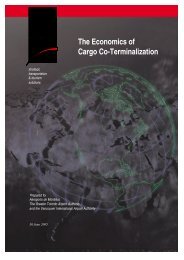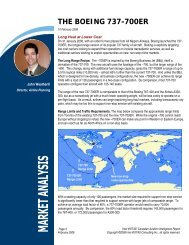B747-8F VS A380F - InterVISTAS
B747-8F VS A380F - InterVISTAS
B747-8F VS A380F - InterVISTAS
You also want an ePaper? Increase the reach of your titles
YUMPU automatically turns print PDFs into web optimized ePapers that Google loves.
<strong>B747</strong>-<strong>8F</strong> <strong>VS</strong> <strong>A380F</strong>December 2005Robert AndriulaitisDirector, Transportation &Logistics StudiesFor some time now, Boeing’s 747 family of freighters has dominated the international air cargomarket. With over 200 747 freighters in operation, these aircraft carry about half the world’s airfreight.A while back Airbus challenged Boeing’s supremacy in the large freighter category with thedevelopment of the 150-tonne capacity <strong>A380F</strong> to compete with the 113tonne 747-400F. Boeing had been studying the market feasibility of astretched 747 for a number of years, but turned itsattention early in 2001 to the development of theSonic Cruiser. Boeing also indicated it felt thatAirbus had overestimated the demand for very large aircraft. With changesin the market since the Sonic Cruiser was first announced, Boeing focussedits attention back to the 747 in a big way, and has now responded with itsnew 140 tonne 747-<strong>8F</strong>.So how do the two freighters compare?Capacity. The <strong>A380F</strong> offers 150 tonnes of payload and 938.4 cubic metres of space. While the747-<strong>8F</strong> offers significantly more capacity than the 747-400F at 140 tonnes payload and 854.3 cubicmetres of space, the <strong>A380F</strong> still provides 7% greater payload and 10% greater volume. Boeing hason occasion referred to the ability of its aircraft to handle “real world” densities (by implicationsuggesting Airbus aircraft do not); however, the 747-<strong>8F</strong> could only carry slightly more dense cargothan the <strong>A380F</strong>, at an average of 164 kg/m 3 versus 160 kg/m 3 . It is doubtful that this will give it muchof an advantage, so the A380 clearly offers greater cargo carrying capacity.Range. Based on aircraft characteristics downloaded from the Airbus website, the <strong>A380F</strong> can flyabout 10,400 to 10,500 km with a full payload, depending on engine choice. The 747-<strong>8F</strong> will have amaximum range of about 8,275 km. Clearly, the <strong>A380F</strong> has a significant advantage here. If we lookat the ability to carry 140 tonnes (the 747-<strong>8F</strong> maximum), the difference is more pronounced, with the<strong>A380F</strong> being able to cover some 11,400 km. From a point such as Dubai, the 747-<strong>8F</strong> can reach all ofEurope and Africa, as well as most of Asia. It cannot, however, reach the Americas. The <strong>A380F</strong>, onthe other hand, can reach into North America as far asWashington, and can cover all of Asia and even virtually allof Australia (though the key communities on the southeastcoast are just out of range). If the <strong>A380F</strong> were to be loadedwith 113 tonnes (the maximum payload of today’s 747-400F), it could reach any point other than southernCalifornia, Mexico and Central America, the western half ofSouth America and New Zealand. A clear edge to theGreat Circle Mapper<strong>A380F</strong>.Economics of Operation. Here the data is murky. Boeing is claiming 20 percent lower tripcosts, and 23% lower ton-mile costs than the A380. It attributes this to the fact that the empty weightof a 747-<strong>8F</strong> is 86 tonnes less than that of the <strong>A380F</strong>, which translates into less fuel required to movethe airplane itself. Airbus has responded that the Boeing calculations are based on overstated weightand fuel burn numbers for the <strong>A380F</strong>. Some comments made with respect to the passenger versionsuggest the Boeing advantage may be closer to 12% on a trip cost basis. Nevertheless, it wouldseem that Boeing has a very important edge here.Page 1December 2005<strong>InterVISTAS</strong>’ Canadian Aviation Intelligence ReportCopyright ©2005 <strong>InterVISTAS</strong> Consulting Inc., all rights reserved.
<strong>B747</strong>-<strong>8F</strong> <strong>VS</strong> <strong>A380F</strong> – CON’TCost. The <strong>A380F</strong> lists at about $282 million; the 747-<strong>8F</strong> at about $278 million. Not much to choosefrom here. Of course, the actual price can vary significantly from the list price, depending on the aircarriers’ negotiating leverage and the aerospace manufacturers’ hunger for sales.Airport Issues. Both aircraft will meet Stage 4 and QC2 noise requirements. (QC refers toQuota Count, in use at London airports for night flights.) Comparative emissions levels are hard todetermine given the mixed signals on relative fuel burn.The 747-<strong>8F</strong>, though larger than the 747-400F, will operate at existing airports handling the 747-400.The A380, as has been widely noted, requires modifications at some airports in order to handle thisvery large aircraft.There have also been some concerns that wake turbulence from the A380 may require longer waitsbetween take-offs. This could be an issue at congested airports – an ironic situation as one of themotivations for the A380 was to reduce congestion at hub airports.Conclusions. At this early point in time, with few hard numbers on performance, it is difficult tosay which aircraft is “better.” As well, which is “better” will vary by carrier, depending on its needs. Sofar, Cargolux has ordered 10 747-<strong>8F</strong>s and Nippon Cargo Airlines has ordered 8. The <strong>A380F</strong> hasbeen ordered by Emirates (2), FedEx (10), International Lease Finance Corporation (5) and UPS (10firm and options for another 10). It is certain that both aircraft will become important fixtures in theinternational air cargo world.Page 2December 2005<strong>InterVISTAS</strong>’ Canadian Aviation Intelligence ReportCopyright ©2005 <strong>InterVISTAS</strong> Consulting Inc., all rights reserved.








